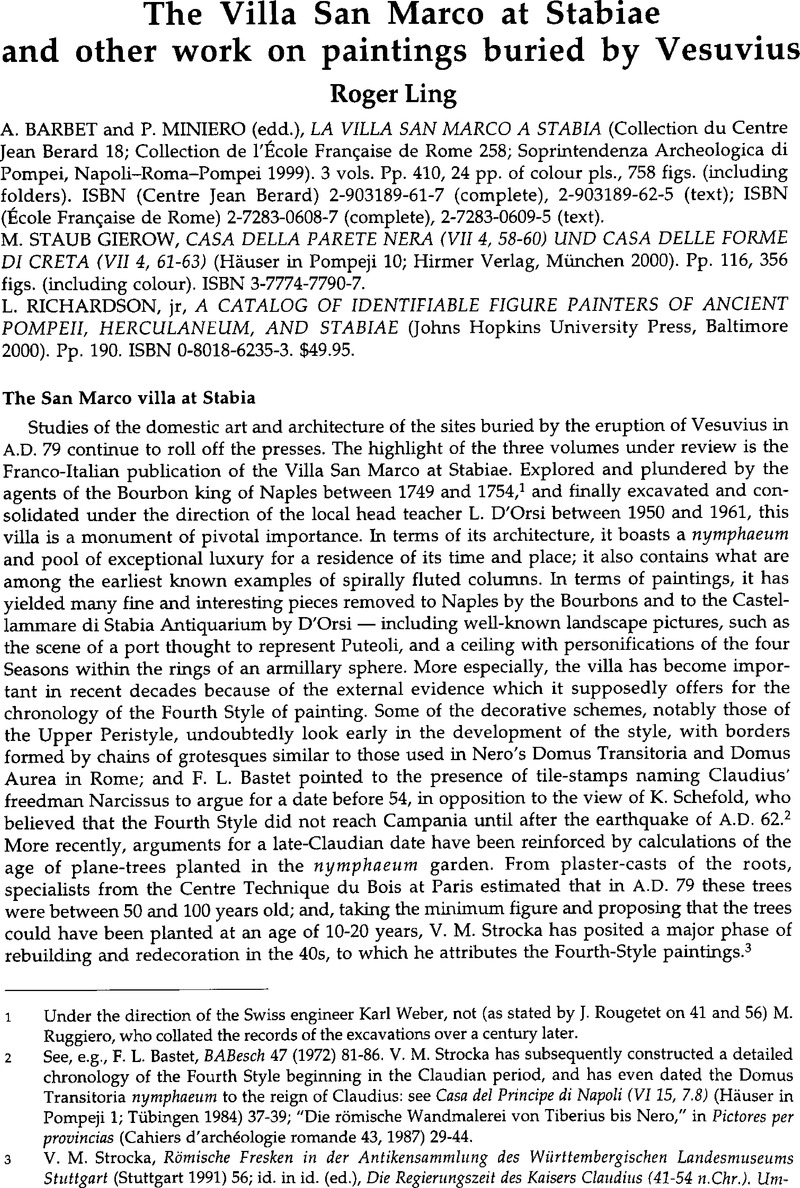No CrossRef data available.
Article contents
The Villa San Marco at Stabiae and other work on paintings buried by Vesuvius - A. Barbet and P. Miniero (edd.), LA VILLA SAN MARCO A STABIA (Collection du Centre Jean Berard 18; Collection de l'École Française de Rome 258; Soprintendenza Archeologica di Pompei, Napoli–Roma–Pompei 1999). 3 vols. Pp. 410, 24 pp. of colour pls., 758 figs. (including folders). ISBN (Centre Jean Berard) 2-903189-61-7 (complete), 2-903189-62-5 (text); ISBN (École Française de Rome) 2-7283-0608-7 (complete), 2-7283-0609-5 (text). - M. Staub Gierow, CASA DELLA PARETE NERA (VII 4, 58-60) UND CASA DELLE FORME DI CRETA (VII 4, 61-63) (Häuser in Pompeji 10; Hirmer Verlag, München 2000). Pp. 116, 356 figs. (including colour). ISBN 3-7774-7790-7. - L. Richardsonjr , A CATALOG OF IDENTIFIABLE FIGURE PAINTERS OF ANCIENT POMPEII, HERCULANEUM, AND STABIAE (Johns Hopkins University Press, Baltimore 2000). Pp. 190. ISBN 0-8018-6235-3. $49.95.
Published online by Cambridge University Press: 16 February 2015
Abstract

- Type
- Reviews
- Information
- Copyright
- Copyright © Journal of Roman Archaeology L.L.C. 2002
References
1 Under the direction of the Swiss engineer Karl Weber, not (as stated by J. Rougetet on 41 and 56) M. Ruggiero, who collated the records of the excavations over a century later.
2 See, e.g., Bastet, F. L., BABesch 47 (1972) 81–86 Google Scholar. V. M. Strocka has subsequently constructed a detailed chronology of the Fourth Style beginning in the Claudian period, and has even dated the Domus Transitoria nymphaeum to the reign of Claudius: see Casa del Principe di Napoli (VI 15, 7.8) (Häuser in Pompeji 1; Tübingen 1984) 37–39 Google Scholar; “Die römische Wandmalerei von Tiberius bis Nero,” in Pictores per provincias (Cahiers d'archéologie romande 43, 1987) 29–44 Google Scholar.
3 Strocka, V. M., Römische Fresken in der Antikensammlung des Württembergischen Landesmuseums Stuttgart (Stuttgart 1991) 56 Google Scholar; id. in id. (ed.), Die Regierungszeit des Kaisers Claudius (41-54 n.Chr.). Umbruch oder Episode? (Mainz 1994) 200 f. But cf. Ling, R. in BJb 193 (1993) 510 Google Scholar.
4 D'Orsi, L., Gli scavi di Stabia (Napoli 1954)Google Scholar; Come ritrovai l'antica Stabia (Napoli 1956; 3rd edn., Castellammare di Stabia 1974)Google Scholar.
5 Elia, O., Le pitture di Stabia (Napoli 1957)Google Scholar.
6 Elia, O., “La villa stabiana di San Marco,” Napoli nobilissima 2 (1962) 43–51 Google Scholar; ead., “Stabiae,” EAA 7 (1966) 459–63Google Scholar.
7 As often at Pompeii and Herculaneum, the materials used in the restoration were incompatible with the ancient fabric: the reinforced concrete of the entablature proved too heavy for the supporting columns.
8 Bedel, A. Allroggen, “Die Wandmalereien aus der Villa in Campo Varano (Castellammare di Stabia),” RömMitt 84 (1977) 27–89 Google Scholar.
9 Not to mention disagreements, for example on the length of the incompletely excavated Upper Peristyle (see 265, 365): on the basis of predictions from the ceiling paintings, R. Nunes Pedroso opts for 15 columns, while A.-S. Leclerc uses a supposedly axial figure in the wall-paintings to argue for 13.
10 It is symptomatic of the problems that on 363 it is clearly stated that only the baths are truly oriented N-S, yet on 364 we are told that room 39, which is in a different part of the villa, has a NW angle.
11 E.g., references to the illustrations, given in the margins of the text, are often wrongly placed or erroneous. Other basic defects include the transposition of two pages (34 and 35), the transposition of two captions (figs. 341 and 344), the wrong scale on a drawing (fig. 412), and the same description repeated almost verbatim in successive paragraphs (179).
12 Thus on 155 M.-O. Savarit and A. Barbet argue that Rougetet's view that the pilaster between the opening of the tablinum (59a) and the andron (59b) was rebuilt and repainted tends to be invalidated by the fact that the red painting of the pilaster was no different from that of other parts of the atrium.
13 Pisapia, M. S., MosAntIt. Regione prima. Stabiae (Roma 1989)Google Scholar.
14 In this summary (83), the early mosaic pavement of a corridor under room 10 is said to belong to the Third Style, but in the catalogue (80) it is ascribed to the Third to Fourth Style phase. What is described in the summary as a single Fourth-Style phase identified in the atrium, the baths and the peristyle is divided in the catalogue (80-82) between three separate phases. One of the criteria used in the summary for a Third-Style dating of the threshold of room 39, “la scacchiera minuta”, also appears in the threshold of room 32, assigned in the catalogue (80) to the Third-Fourth Style.
15 For the decoration in question, see Varone, A., RStPomp 3 (1989) 236f.Google Scholar; RStPomp 4 (1990) 206–8, figs. 45Google Scholar; id., “L'organizzazione del lavoro in una bottega di decoratori: le evidenze dal recente scavo pompeiano lungo Via dell'Abbondanza,” MededRom 54 (1995) 124-36.
16 de Vos, M., “La bottega di pittori di via di Castricio,” in Pompei 1748-1980. I tempi della documentazione (exh. cat., Roma 1981) 119–30Google Scholar.
17 Richardson, L., Pompeii: the Casa dei Dioscuri and its painters (MAAR 23, 1955)Google Scholar.
18 For pertinent comments on some recent negative views on the chronology of the Four Styles, see Tybout, R. A., JRA 14 (2001) 33–42 Google Scholar.
19 Ehrhardt, W., Stilgeschichtliche Untersuchungen an römischen Wandmalereien von der späten Republik bis zur Zeit Neros (Mainz 1987)Google Scholar.




